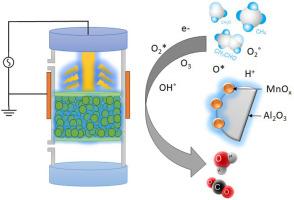Innovations and future directions in hybrid non-thermal plasma-catalyst systems for VOC decomposition
IF 7.1
Q1 ENGINEERING, CHEMICAL
引用次数: 0
Abstract
Volatile organic compounds (VOCs) are challenging to abate because conventional thermal and adsorption approaches trade high energy use for incomplete mineralization and by-product formation. Hybrid non-thermal plasma–catalyst (NTP–catalyst) systems address these limits by coupling plasma-generated oxidants with surfaces that steer reaction pathways at near-ambient bulk temperatures. This review examines NTP–catalyst performance across dielectric-barrier discharge, corona, and gliding-arc reactors, and across catalysts including oxygen-vacancy-rich MnOx and CeO2, TiO2, zeolites, metal-organic frameworks (MOFs), and noble-metal dopants. We organize disparate results using five “matchings”: (i) position (in-plasma vs post-plasma placement), (ii) time-scale (microsecond plasma pulses vs millisecond–second surface kinetics), (iii) energy (specific input energy (SIE) optima beyond which carbon balance and CO2 selectivity degrade), (iv) material (multi-metal sites and vacancy engineering), and (v) operation (temperature, humidity, and residence time). We synthesize trends on conversion, CO2 selectivity, ozone slip, and partial-oxidation by-products, and discuss durability (coking, halogen/sulfur poisoning, plasma aging) alongside mitigation via robust supports, sacrificial oxygen, and periodic regeneration. Finally, we chart future directions: Nanosecond repetitively pulsed (NRP) and frequency-tunable power supplies; structured catalysts and reactors (honeycomb, packed/fluidized beds, and 3D-printed dielectrics) for uniform plasma–solid contact; multi-process hybrids (plasma + photocatalysis/ozonation) to lower energy intensity; in-situ/operando diagnostics and microkinetic–plasma modeling; and data-driven control (AI/ML) for real-time optimization and scale-up. This synthesis provides design guidance and research priorities toward industrially scalable, energy-efficient VOC abatement.

挥发性有机化合物分解的非热等离子体-催化剂混合系统的创新和未来方向
挥发性有机化合物(VOCs)的减排具有挑战性,因为传统的热和吸附方法会导致不完全矿化和副产品形成的高能耗。非热等离子体催化剂(NTP-catalyst)混合系统通过将等离子体产生的氧化剂与表面耦合,在接近环境的体温下引导反应途径,解决了这些限制。本文综述了ntp -催化剂在介质阻挡放电、电晕和滑动弧反应器中的性能,以及包括富氧MnOx和CeO2、TiO2、沸石、金属有机框架(mof)和贵金属掺杂剂在内的催化剂的性能。我们使用五种“匹配”来组织不同的结果:(i)位置(等离子体内与等离子体后放置),(ii)时间尺度(微秒等离子体脉冲与毫秒秒表面动力学),(iii)能量(碳平衡和二氧化碳选择性退化的比输入能量(SIE)最佳值),(iv)材料(多金属位点和空缺工程),以及(v)操作(温度,湿度和停留时间)。我们综合了转化、CO2选择性、臭氧滑动和部分氧化副产物的趋势,并讨论了耐久性(焦化、卤素/硫中毒、等离子体老化)以及通过坚固的支撑、牺牲氧气和定期再生来缓解。最后,我们描绘了未来的发展方向:纳秒重复脉冲(NRP)和频率可调电源;用于均匀等离子体-固体接触的结构化催化剂和反应器(蜂窝,填充/流化床和3d打印电介质);多工艺混合(等离子体+光催化/臭氧化),降低能量强度;原位/operando诊断和微动力学等离子体模型;以及用于实时优化和扩展的数据驱动控制(AI/ML)。这种综合为工业上可扩展、节能的VOC减排提供了设计指导和研究重点。
本文章由计算机程序翻译,如有差异,请以英文原文为准。
求助全文
约1分钟内获得全文
求助全文
来源期刊

Chemical Engineering Journal Advances
Engineering-Industrial and Manufacturing Engineering
CiteScore
8.30
自引率
0.00%
发文量
213
审稿时长
26 days
 求助内容:
求助内容: 应助结果提醒方式:
应助结果提醒方式:


